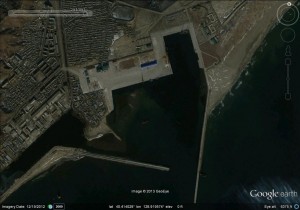
Pictured Above (2012-12-13): Tanchon Port
UPDATE 2 (2013-4-25): Yonhap reports on the DPRK’s plans for the Tanchon Port:
North Korea is scurrying to develop the resources-rich city of Tanchon on the east coast as part of the country’s efforts to make it a source of foreign currency income, recent news reports from the North showed.
Tanchon will become a key transit point in shipping goods to and from Russia’s Siberia, the northeastern part of China and Mongolia, said the Wednesday issue of the Choson Sinbo, a Korean language newspaper published by North Korean nationals in Japan.
The newspaper, a mouthpiece of North Korea, said the port city of Tanchon should become the source of finance for the country’s broader policy line of pursuing both economic development and nuclear capacities.
In a bid to boost exports, the country completed the construction of a port in May last year in the city with rich reserves of magnesite, zinc and other mineral resources, which sits about in the middle of the country’s east coast line. the Choson Sinbo said the city has about 5.4 billion tons of magnesite deposit, possibly the third biggest reserve in the world.
The news outlet also highlighted the country’s planned ways to increase earnings in the resources-rich city from which the country used to export mineral resources to China for meager profits.
“North Korea will move to manufacture processed magnesite goods in order to make high-value added goods,” the Choson Sinbo noted. “To that end, many plants will be built in the Tanchon region and the areas will become a new industrial zone.”
North Korean leader Kim Jong-un has also underlined the country’s plan to boost profits from the Tanchon development, saying in a national meeting of light industrial workers last month that profits from Tanchon development should be exclusively used to prop up the livelihood of North Korean people.
UPDATE 1 (2012-5-3): KCNA announces the completion of the Tanchon Port:
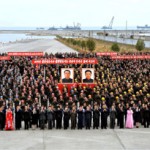
A modern trading port made its appearance in the area of Tanchon in South Hamgyong Province on the occasion of the 100th anniversary of President Kim Il Sung’s birth.
The construction of the port with a cargo traffic capacity of millions of tons provides a guarantee for greatly contributing to developing the nation’s foreign trade and improving the people’s living standard.
A ceremony for the completion of the construction was held on the spot Thursday.
Present there were Choe Yong Rim, Kwak Pom Gi, Ro Tu Chol and other officials concerned, officials of the Ministry of Land and Marine Transport, builders and working people of industrial establishments in Tanchon City.
Read out there was a joint congratulatory message sent by the Central Committee of the Workers’ Party of Korea and the Cabinet of the DPRK to the officials and members of shock brigades who performed labor feats in the construction of the port.
The message highly praised them for successfully building another giant structure in the era of Songun greatly conducive to building an economic power true to the life-time desires and last instructions of President Kim Il Sung and leader Kim Jong Il.
It expressed belief that they would perform greater feats in the efforts for the country’s prosperity united close around the WPK Central Committee headed by the dear respected Kim Jong Un.
Minister of Land and Marine Transport Kang Jong Gwan, in his speech made for the occasion, said the construction of the port was a brilliant fruition of the wise leadership of Kim Jong Il who initiated the construction of the port and worked heart and soul to translate the desire of the President into a reality till the last moments of his revolutionary life and the clear-sighted guidance and meticulous care of Kim Jong Un.
Speakers at the ceremony pledged themselves to carry out their tasks including dredging in a short span of time in the same spirit as displayed in the construction of the port.
At the end of the ceremony the participants looked round different places of the port.
You can see video of the port inauguration here. (KCNA)
Just a few days ago, the Choson Sinbo reported the following (via Yonhap):
The North is estimated to have 15 billion tons of anthracite coal, a key mineral Pyongyang uses to produce steel, the Choson Sinbo newspaper said.
The North also has an estimated 5.4 billion tons of magnesite in Tanchon, a home to mines in South Hamgyong province, and other areas, according to the newspaper.
North Korea is set to open Tanchon as a modern trade port, the newspaper said, without giving any specific time frame for the opening.
ORIGINAL POST (2010-12-9): On December 2, KCNA announced that Kim Jong-il visited the port in Tanchon County, South Hamgyong County (40.412522°, 128.917731°) where he gave guidance on the port’s reconstruction.
Judging by the satellite imagery of the area on Google Earth, it appears that the project had already begun by May 13, 2009, where we can see concrete blocks ready to be used to extend the jettys (breakwaters). I have outlined the proposed port project on Google Earth imagery below and provided a picture of the completed project from KCTV:
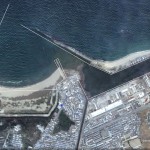
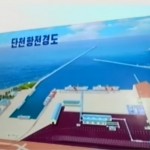
After the jettys are extended, the major construction work and dredging can begin. Below are images of the port’s main construction site as it appears on Google Earth and a prediction of the project’s conclusion from KCNA:
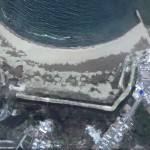
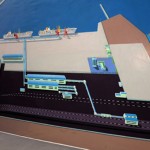
It appears from the picture that the port will be connected to the railway system—likely via the nearby Tanchon Smeltery and Magnesia Plant (both recently renovated) whose products will probably be exported from the port.
Tanchon is also home to the DPRK’s Komdok and Taehung Youth Hero Mines (among others). As is well known to readers, raw materials exports are the DPRK’s most significant (legal and transparent) source of hard currency. According to Yonhap’s North Korea Handbook 2002:
Geomdeok [Komdok] Mine is a special company in Bonsan-dong, Dancheon, South Hamgyeon Province, and is very famous for about 300 million tons of deposited leads and zincs. This mine annually produces 52,000 tons of lead, 124,000 tons of zinc, both of which account for 47% of total production in North Korea, and more than twice as much as the production of Eunpa Mine, North Korea’s second largest mine, in Eunpa-gun North Hwanghae Province. Concentrates of lead and zinc produced from Geomdeok Mine are processed into electric zinc at Dancheon refinery. Opened in 1932, this mine produces 14,200 tons of raw ore annually with three ore dressing plants. Annual production capacity can reach up to 11 million tons. The first dressing plant was completed in July 1953, near the end of the Korean War. It now processes a million tons of ore a year. The second dressing plant was opened with a production capacity of 3,200 tons of ore. The third one constructed in September 1983 can process 10 million tons of ore.






